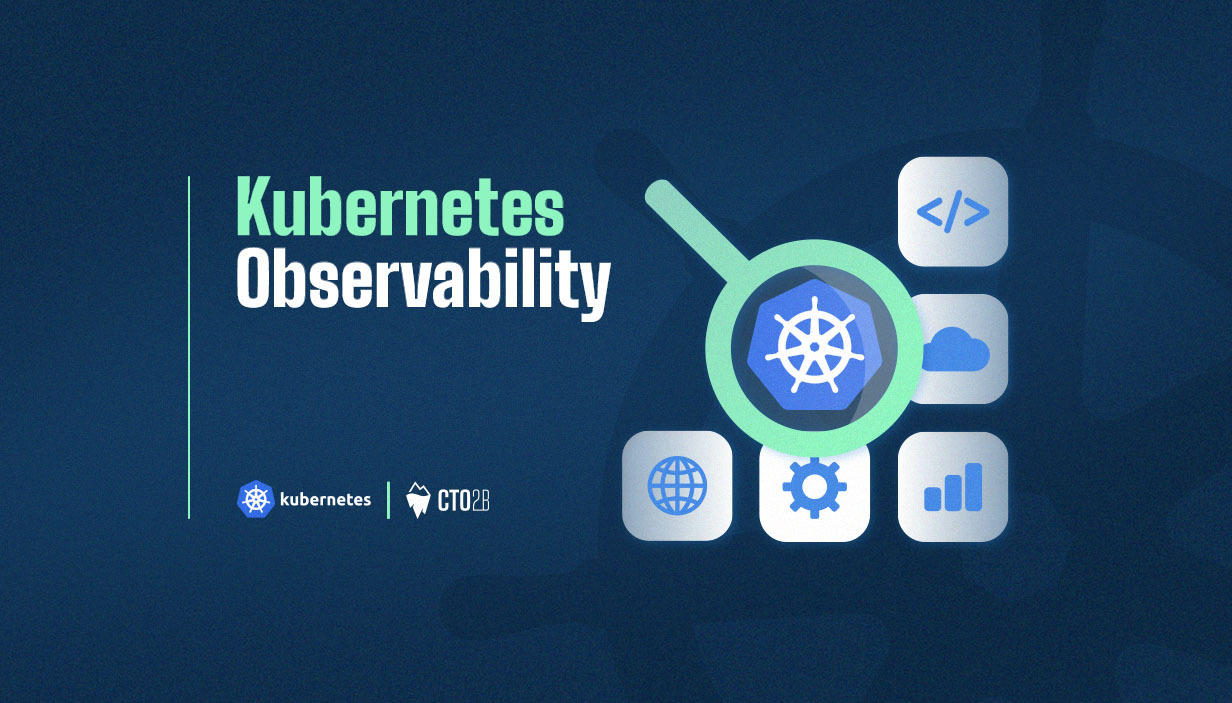Kubernetes has become the backbone of modern cloud-native applications, enabling organizations to deploy, scale, and manage containerized workloads efficiently. But as clusters grow in size and complexity, Kubernetes evolves into a dynamic, scalable kubernetes environment and a complex system with many interconnected parts, requiring specialized approaches to monitoring and troubleshooting. This is where Kubernetes observability comes in, which is a critical practice for maintaining reliable, high-performing, and cost-effective systems, and where modern observability solutions play a vital role.
In this guide, you’ll learn what Kubernetes observability is, why it matters, how it differs from monitoring, and how to implement it effectively using best practices and leading tools.
What is Kubernetes Observability?
Kubernetes observability is the ability to gain deep insight into the state and behavior of your Kubernetes clusters and the workloads running within them. Unlike basic monitoring, which focuses on tracking predefined metrics, observability empowers you to ask new questions about your system and get meaningful answers even when issues are unexpected. Monitoring focuses on predefined metrics and issue detection, while observability focuses on understanding system behavior through various data sources.
Observability in Kubernetes relies on three fundamental data sources: metrics, logs, and traces (often referred to as metrics logs and traces). By integrating these pillars, teams can understand not just what is happening but why it is happening, enabling faster troubleshooting and smarter optimization.
If you’re new to Kubernetes, check out our introduction to what is kubernetes to understand its core concepts and architecture. This foundational knowledge will help you appreciate the importance of comprehensive observability as your environment scales. To achieve this, you need to collect data from multiple sources and analyze data to gain deep insights into your system.
Why Kubernetes Observability Matters
The dynamic, distributed nature of Kubernetes brings significant benefits but also unique challenges:
Reliability: With microservices deployed across ephemeral pods and nodes, failures can cascade quickly. Observability helps you detect and resolve issues before they impact users.
Performance: Identifying bottlenecks and optimizing resource allocation require comprehensive visibility into how workloads interact. Monitoring resource usage and resource utilization metrics is essential to optimize workloads and improve application performance.
Troubleshooting: Pinpointing the root cause of failures in a complex environment demands more than just surface-level metrics. Deep observability helps identify issues and identify performance bottlenecks by analyzing metrics, logs, and resource data.
Cost Optimization: Observability reveals underutilized or over-provisioned resources, supporting effective cloud cost optimization and smarter budgeting. Considering the entire system, including the underlying infrastructure, is crucial for comprehensive cost and performance management.
For teams managing multi-cloud or hybrid environments, observability is even more crucial. Learn more about managing multi-cloud Kubernetes for strategies on handling complexity across cloud providers and ensuring smooth operations.
The Three Pillars of Kubernetes Observability
Logs
Logs are detailed records of events and actions within your cluster. They’re invaluable for debugging, auditing, and understanding what happened at specific points in time. Kubernetes logs can originate from applications, system components, or the platform itself. Effective log management is essential for handling the large volumes of log data generated in Kubernetes environments, ensuring that critical information is available for troubleshooting and maintaining system health.
Best practices:
- Centralize log collection for easier searching and analysis.
- Use structured logging (e.g., JSON) to enhance query capabilities.
- Implement log rotation and retention policies to manage storage.
Metrics
Metrics provide quantitative insights into system health and performance. Common metrics include CPU and memory usage, pod restarts, and request latency. Monitoring metrics such as kubernetes metrics, custom metrics, and memory consumption are essential for real-time system health analysis and identifying performance bottlenecks.
Why they matter:
- Enable real-time monitoring and alerting.
- Support capacity planning and autoscaling.
- Reveal trends and anomalies for proactive management.
Traces
Traces follow the journey of individual requests as they traverse multiple services. In Kubernetes, tracing is essential for understanding dependencies and pinpointing where delays or failures occur in distributed systems. Data correlation between trace data and other observability sources, such as logs and metrics, enables more accurate troubleshooting by connecting issues across complex systems.
Benefits:
- Visualize request flows across microservices.
- Accelerate root cause analysis.
- Uncover hidden performance bottlenecks.
- Identify bottlenecks and provide deep insights into complex systems, making it easier to optimize performance and troubleshoot distributed architectures.
For a deeper dive into how Kubernetes works and how it compares to other container technologies, read Kubernetes vs Docker. You’ll gain insights on orchestration strategies and observability patterns.
Key Challenges in Kubernetes Observability
Kubernetes observability is powerful, but not without obstacles:
- Disparate Data Sources: Logs, metrics, and traces are scattered across nodes, pods, and external systems.
- Dynamic Infrastructure: Pods and containers are ephemeral, making it hard to track issues over time.
- High Cardinality: The sheer volume and variety of data can overwhelm traditional monitoring tools.
- Security and Compliance: Sensitive data must be protected and audit trails maintained, especially in regulated industries. Explore our guide to cloud compliance for more on meeting regulatory requirements and aligning observability with governance policies.
- Complexity of Monitoring Kubernetes Deployments: Monitoring and understanding kubernetes deployments can be challenging due to their scale and dynamic nature. Effective use of kubernetes dashboards and the kubernetes dashboard tool is essential for visualizing, managing, and troubleshooting clusters.
Different kubernetes distributions, such as Amazon EKS or Rancher, may introduce unique observability challenges and vendor-specific features. Adopting a cloud native observability strategy is crucial to solve kubernetes observability challenges across these diverse environments.
Data Analysis and Correlation in Kubernetes Observability
Effective Kubernetes observability goes beyond simply collecting logs, metrics, and traces. It’s about making sense of this data to drive real improvements in your Kubernetes clusters. Data analysis and correlation are at the heart of this process, enabling teams to transform raw observability data into actionable insights.
By leveraging observability tools that aggregate and correlate logs, metrics, and traces from across your Kubernetes environments, you gain a comprehensive understanding of system behavior. This holistic view is essential for identifying performance bottlenecks, uncovering hidden dependencies, and detecting anomalies that could impact system performance.
Correlating data from multiple sources allows you to pinpoint the root cause of issues faster. For example, a spike in request latency revealed by metrics can be traced back to specific log entries or trace data, helping you quickly identify and resolve bottlenecks. This end-to-end visibility is especially valuable in complex, distributed systems where issues often span multiple components and services.
Ultimately, robust data analysis and correlation empower you to optimize performance, improve reliability, and maintain the health of your Kubernetes clusters. By continuously analyzing logs, metrics, and traces, you can proactively address issues before they escalate, ensuring your Kubernetes environments run smoothly and efficiently.
Implementing Kubernetes Observability: Step-by-Step
Define Objectives and KPIs
Start by identifying what you want to achieve whether it’s reducing downtime, improving performance, or controlling costs. Define clear key performance indicators (KPIs) aligned with your business goals.
Choose the Right Tools and Frameworks
Select observability tools that fit your needs and environment. Popular open-source options include Prometheus for metrics, Fluentd for logs, and Jaeger for traces. For advanced features and unified monitoring, consider a comprehensive observability platform or explore leading observability platforms that integrate seamlessly with Kubernetes. When choosing, evaluate Kubernetes monitoring tools and observability solutions for compatibility with your environment. For integrated environments, observability should work hand-in-hand with broader cloud infrastructure management practices.
Set Up Logging, Metrics, and Tracing
Deploy log collectors (e.g., Fluentd, Logstash) as DaemonSets to capture log data from all pods and nodes for effective log management.
Install metrics servers and configure Prometheus to scrape relevant Kubernetes metrics endpoints. For efficient data collection and enhanced observability, consider using extended Berkeley Packet Filter (eBPF) technology, which operates in kernel space.
Implement distributed tracing with OpenTelemetry or Jaeger for end-to-end visibility.
Integrate with CI/CD Pipelines
Automate the deployment and configuration of observability tools as part of your DevOps automation process. This ensures consistency across environments and reduces manual configuration. By integrating observability tools with your CI/CD pipelines, you can automatically analyze data from pre-production environments, enabling early detection of issues and validation of your observability setup.
Configure Alerts and Dashboards
Set up alerts for critical thresholds and visualize trends with dashboards in Grafana or similar tools. Kubernetes dashboards are essential tools for monitoring, managing, and enhancing the observability of Kubernetes clusters, simplifying cluster operations. The built-in Kubernetes Dashboard provides a user interface for cluster monitoring, visualization, and troubleshooting. Focus on actionable alerts to avoid fatigue.
Establish Baselines and Continuous Improvement
Monitor your system under normal conditions to establish baselines. Continuously refine your observability strategy as your infrastructure evolves. If you’re planning to modernize or move your workloads, review our cloud migration insights for guidance on maintaining visibility throughout the transition.
Best Practices for Kubernetes Observability
- Centralize Data Collection: Aggregate logs, metrics, and traces into unified platforms for easier correlation and analysis.
- Consistent Tagging and Labeling: Use standardized labels on Kubernetes resources to streamline querying and filtering.
- Automate Data Collection: Leverage Kubernetes’ service discovery to automate observability at scale.
- Cost Optimization: Regularly review data retention and collection settings to control spending. See our cloud cost optimization guide for best practices.
- Contextual Alerts: Configure alerts that correlate across observability pillars to reduce noise and speed up issue resolution.
Top Tools and Solutions for Kubernetes Observability
A robust observability stack often combines multiple tools:
- Prometheus: Industry-standard for metrics collection.
- Grafana: Powerful visualization and dashboarding.
- Fluentd / Logstash: Flexible log aggregation.
- Jaeger / OpenTelemetry: Distributed tracing and instrumentation.
- Vendor Solutions: Managed platforms offer convenience and advanced integrations. Many vendors provide Kubernetes observability solutions that are tightly integrated with specific Kubernetes distributions, such as Amazon EKS or Rancher, offering enhanced observability capabilities and seamless integration with their platforms.
When deploying Kubernetes in major cloud providers, specific observability integrations may apply. For Azure users, our azure Kubernetes article explores native toolsets and telemetry options.
Overcoming Common Kubernetes Observability Challenges
Multi-Cluster and Hybrid Environments: Aggregate data across clusters for a unified view. Implement strategies to solve Kubernetes observability challenges in multi-cluster and hybrid environments, ensuring seamless monitoring and troubleshooting. Learn more in our cloud migration guide for observability continuity during infrastructure shifts.
High Data Volume: Use sampling, retention policies, and efficient pipelines to manage telemetry data.
Security and Compliance: Encrypt data in transit and at rest, and use role-based access control.
Future Trends in Kubernetes Observability
- AI-Driven Analytics: Machine learning is being used to detect anomalies and automate incident response, providing deep insights into Kubernetes operations.
- Observability-as-Code: Observability configurations are being versioned and deployed through CI/CD pipelines, aligning with a cloud native observability strategy.
- eBPF and Advanced Telemetry: Technologies like eBPF provide deep visibility with low overhead.
- Enhanced Visualization: New dashboards offer better context and usability for DevOps teams.
Closing Thoughts
Kubernetes observability is essential for managing the complexity of modern cloud-native infrastructure. By leveraging logs, metrics, and traces (and adopting best practices and the right tools) you can ensure your clusters stay reliable, performant, and cost-efficient. As your Kubernetes journey evolves, so should your observability strategy.


